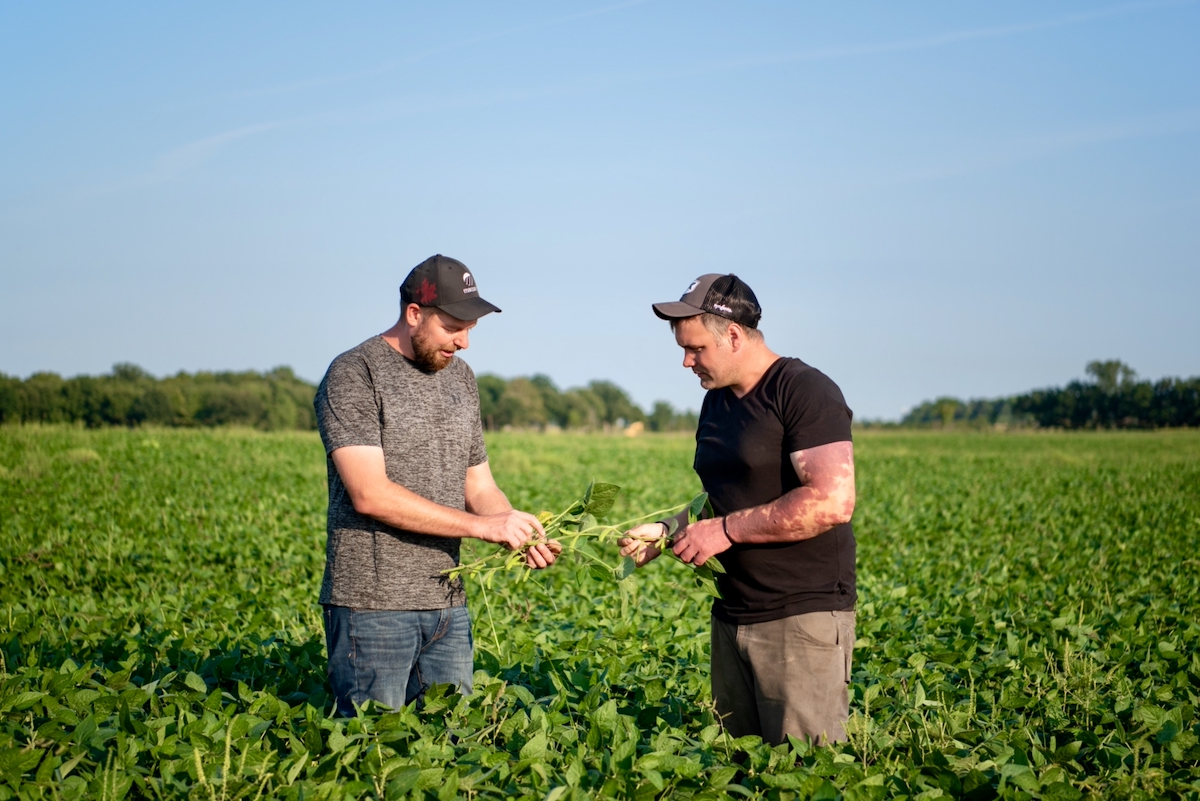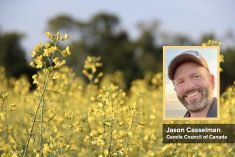Sclerotinia stem rot is the most yield-damaging canola disease in Western Canada, yet payback on fungicide hinges on a “yes” to these three questions: Is canopy moisture through flowering sufficient for high levels of infection? Is yield potential high enough to provide a return? Are the spores present?
The answer to question one depends on assessment of conditions at spray timing and a forecast of continued moisture. This article won’t help with weather forecasting. For question two, if the crop has average or better yield potential, fungicide will preserve enough bushels to justify its cost — as long as moisture is good (see question one) and spores are present. This leads to question three: Are the spores present?
A grower or agronomist could just guess the answer to question three, but they don’t have to. They have three options to test for the presence of spores at the critical early-flowering stage.
Read Also

Ontario farmers partner for success
Ontario business partners, Matt Bergman and DJ Wassenaar, have been farming together for 10 years. Their focus on integrating unconventional…
“We don’t have tests to predict future canopy moisture, but by using these tests to answer the spore question, growers can eliminate half of the uncertainty that always nags at their fungicide decision,” says Clint Jurke, agronomy director with the Canola Council of Canada.
Petal test — Discovery Seed Labs
Discovery Seed Labs in Saskatoon tests canola petals for the presence of sclerotinia spore DNA. The lab can provide results within 24 to 48 hours after receiving samples.
Discovery provides the sampling kit, which has 64 tubes. Ideal sample timing is just before 20 per cent flower, which is when the fungicide spray window opens. The sample collector goes to eight sites within a field and picks two petals from eight spots at each site. Two petals go into each tube. A completed kit will contain 128 petals from one field.
The lab checks each tube for sclerotinia spore DNA, and gives results as a per cent. With the calculator on its website at seedtesting.com, users enter the petal test result along with crop density and moisture during flowering to get a sclerotinia risk assessment.
Sampling kits are $20 each and analysis is $179 for a total of $199 per test. Discovery will have kits ready by around mid-May. Call 306-249-4484 or email [email protected] to order.
Petal test — Quantum Genetix
Quantum Genetix in Saskatoon also tests canola petals for sclerotinia spore DNA. The Q-protect test is based on three petals collected from five sites per field and eight spots per site — so 40 tubes per field. The three petals per tube should come from the top, middle and bottom of the flowering canopy.
“All five sample sites should be in the same field to maintain confidence in the analysis,” says Heather Deobald, general manager of Quantum Genetix. Each test is for a field of 320 acres or smaller.
Cost is $480 per test. Quantum Genetix can provide results within 24 hours of receiving the sample. Deobald recommends sampling within the fungicide spray window.

Results are shown as a risk barometer. If fewer than 20 per cent of tubes are positive, the field is considered low risk. If greater than 40 per cent are positive, Deobald says the field will likely benefit from a spray as long as moisture is present and the field has moderate to high yield potential. Quantum Genetix has an app to calculate risk based on petal test results, canola price and yield potential.
For more information, contact Heather Deobald at [email protected] and 306-956-2092, or visit quantumgenetix.com.
Spornado — 20/20 Seed Labs
The funnel-shaped Spornado from 20/20 Seed Labs in Nisku, Alta., traps airborne spores in a canola field. Analysts at 20/20 use these trap counts to give an estimate of risk.
Kim Kenward, research and development manager with 20/20 Seed Labs, says to put Spornado in an open area within the field, away from airflow restrictions like trees and buildings, about a foot above the plant canopy. Deploy Spornado about a week before the fungicide spray window opens and leave the spore-capturing cassette in place for two to four days before sending it to the lab.

After 20/20 receives the cassette, final results are available online within 24 hours. The lab measures the amount of DNA detected. If spore DNA amounts are not detected or are at trace levels, 20/20 considers the field to be a low risk for sclerotinia stem rot. If DNA reaches the base “limit of detection,” risk is medium and Kenward says to watch the weather to see if moisture conditions are right for infection. DNA levels greater than five times the “limit of detection” are considered high risk. “The highest we’ve seen so far is 100 times the limit of detection,” Kenward says.
The Spornado trap is $490 and it comes with two cassettes. Analysis cost is included with the cassette, so this purchase price includes two tests. Extra cassettes are $120 each, including analysis. For more information, email [email protected] or call 877-420-2099. The website is 2020seedlabs.ca.
Infection starts with spores
The sclerotinia stem rot infection cycle begins with spores landing on petals. With spores confirmed, the decision to spray fungicide comes down to an assessment of humidity in the canopy now and an estimate of rainfall and humidity over the following weeks. Limitations in weather forecasting will keep the fungicide decision somewhat challenging, but spore tests eliminate a big chunk of the uncertainty.
Moisture: The major sclerotinia risk factor
The Canola Council of Canada is working on an upgrade to the sclerotinia risk checklist and hopes to have something ready for 2022. The old checklist is still available in the sclerotinia stem rot chapter at canolaencyclopedia.ca.
The major risk factor will always be moisture. Sclerotia in the soil need moisture to germinate and produce apothecia, the tiny mushrooms that release sclerotinia spores. Moisture during and after flowering will promote infection that can lead to an economic loss of yield.
Relative humidity above 80 per cent for long stretches in June and July will increase sclerotinia stem rot risk. Note that humidity is usually higher in the canopy. If pants get wet on an early-afternoon walk through the field, one can assume the field has favourable conditions for disease.
Jay Whetter is communications manager with the Canola Council of Canada.















